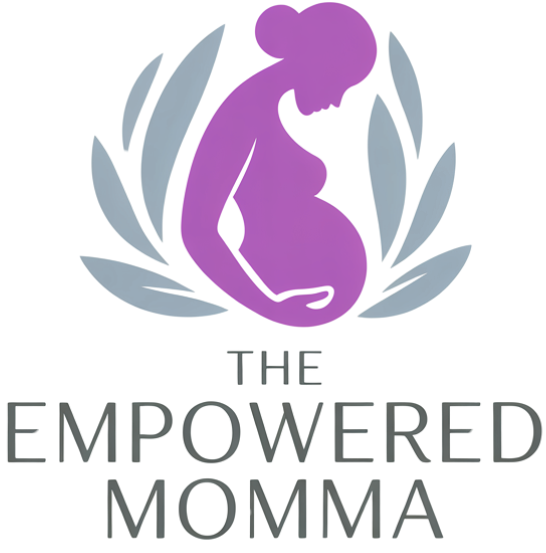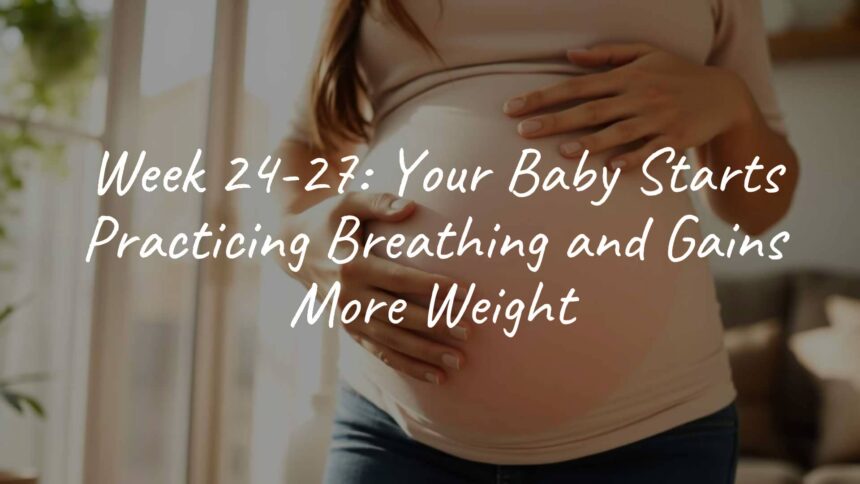Between weeks 24 and 27 of pregnancy, your baby is getting ready for life outside the womb. This is when they start practicing breathing movements and continue to put on more weight. During this stretch of time, their organs are developing quickly, and their body is preparing for birth by building up fat and muscle.

What’s happening during weeks 24-27 of pregnancy?
These weeks keep you and your baby busy. Starting at week 24, you are now six months pregnant, and by week 27, you’re finishing the second trimester. Your body is stretching and changing to fit your growing baby. At this stage, your uterus usually sits above your belly button, and you might notice you gain about one pound every week.
You may notice it’s harder to keep your balance or you might feel clumsier. Hormones are shifting even more, and the dark line on your belly (linea nigra) might be easier to see. You might feel more tired again and your hunger can grow, so eating a steady, healthy diet helps keep your energy up.

Main milestones between weeks 24 and 27
A lot happens in these weeks. You’ll be feeling your baby moving around more often, sometimes even feeling little hiccups, which can feel like gentle taps or twitches. Even though you’re still in the second trimester, week 27 is when it winds down and you’re close to starting the third trimester.
Typical pregnancy symptoms at this point include:
- Round ligament pain in your lower belly as your uterus stretches
- Headaches or migraines due to hormone changes
- Nasal stuffiness
- Mild swelling in your hands and feet
- Heartburn from your growing uterus pressing on your stomach
- Braxton Hicks contractions (practice contractions that aren’t usually painful)
- Changes in your skin, hair, or nails
- Possible leaks of urine when sneezing or coughing due to bladder pressure (“snissing”)

If you’re carrying twins, there are higher chances of early labor, so watch for any unusual symptoms like bleeding or steady contractions.
Doctors usually do routine checkups. Around week 24, you might have the oral glucose tolerance test (OGTT) or a glucose challenge test (GCT) for gestational diabetes. These are usually done between weeks 24 and 28. If your pregnancy is considered higher risk, other checks, like screening for preeclampsia or a fetal fibronectin test, might be offered. This is also a good time to think about signing up for childbirth or antenatal classes to help prepare for delivery and caring for your new baby.
How is your baby growing between weeks 24 and 27?
Your baby is growing fast now. During these weeks, their organs are maturing, and they look more and more like a newborn with each day. Kicks and movements will be stronger, and each day brings something new as they gear up for life outside your body.
How big is your baby? (Weeks 24-27)
| Week | Length (head to toe) | Weight | About the size of |
|---|---|---|---|
| 24 | 30 cm (11.8 in) | 1.3 lbs (590 g) | Ear of corn/A4 paper |
| 27 | 36.5 cm (14.4 in) | 1.9-2 lbs (860-900 g) | Cauliflower/lettuce |
The steady growth in length and weight helps your baby prepare for birth and raises their chances of doing well if they are born early.

Which organs and senses are developing?
Several important changes happen now, especially in your baby’s lungs. Around week 24, their lungs start practicing “breathing” by taking in and pushing out amniotic fluid. They also begin making a special fluid called surfactant that helps their lungs stay open after birth. While the lungs are growing, it’s not until week 28 or later that they are developed enough for some babies born early to breathe on their own, though more growth continues after birth and up to about age 8.
Other changes include:
- Skin becomes thicker, builds up fat, and looks less wrinkled
- Facial features are almost finished forming
- Brain activity increases, with the brain getting bigger and more complex after week 27
- The nervous system continues to grow
- Hearing gets better-your baby might start to recognize your voice and others
- Reflexes develop, including sucking and thumb-sucking
What baby movements should you expect?
Your baby has space to wiggle and turn during these weeks. Their position will likely change often-they may be head-up, head-down, or sideways. It’s too soon for them to settle into a birth position, so expect lots of movement. Besides strong kicks, you may feel light, rhythmic bumps (hiccups). If you have twins, you might feel more activity.
Your baby may have regular times of sleeping and being awake. If you think your baby isn’t moving much, try having something cold to drink, talking to them, putting on music, or changing your own position. Starting next week (week 28), it’s often suggested to start keeping track of how many times your baby moves.
How does your baby “practice” breathing before birth?
Your baby doesn’t breathe air while in the womb. Instead, they make “breathing” movements, moving amniotic fluid in and out of their lungs. This is important for building up the muscles they’ll need to breathe once they’re born and helps their lungs get ready for life outside.
These practice breaths are regular movements of the baby’s chest and diaphragm, pulling amniotic fluid into the lungs and pushing it back out. Oxygen still comes from your blood through the placenta and umbilical cord. These movements help your baby’s respiratory muscles get stronger and support the growth of the air sacs in the lungs.

Practice breathing can start as early as week 10 but is seen much more after week 20. Between weeks 24 and 28, your baby spends about 10 to 20 percent of the time doing these motions. After week 30, this can increase to about 30 to 40 percent of the time. Since your baby gets all their oxygen from you, these movements aren’t constant. It’s normal for them to take breaks from practicing. Ultrasounds in the third trimester can show these healthy practice breaths.
When do the lungs finish developing?
Practice breathing and surfactant production start around week 24, but the lungs aren’t finished until much later. Around week 28, the lungs are developed enough that some babies born early may breathe with help, but they often still need extra medical support and time in a special care nursery. Lungs continue getting ready until around week 37, closer to when most babies are born, and keep growing even after birth until about eight years old.
Good habits during pregnancy-like not smoking and eating well-help your baby’s lung growth. After the baby is born, keeping them away from smoke and encouraging lots of moving and playing will help keep their lungs healthy and strong.

